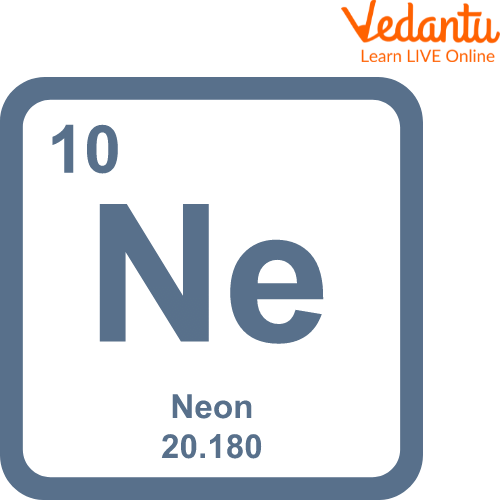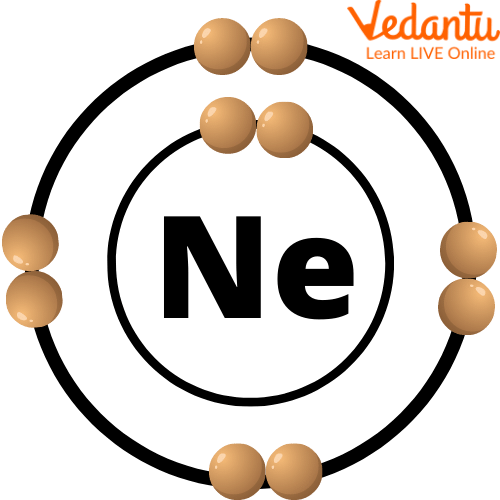




Introduction to Neon Element
Do you know why there is reddish-orange colour in the lamps? It is because of Neon, a gas present in them. Neon is a chemical element that exists in the form of gas in nature. It is chemically inert or not reactive, which means that it does not form compounds with other elements. This gas is denser than air and is found within the rocks in the Earth's crust.

Neon Symbol, Atomic Number and Mass
Neon element is used to manufacture everyday products, such as refrigerators, television, computers, etc.
This article will cover details on the neon atomic number, properties, uses and facts.
What is the Neon Atomic Number?
Neon is the second lightest noble gas in the periodic table after helium. It is because of the stable atomic structure of neon. Scientists have determined the atomic number of neon as 10. The neon symbol is Ne. It has an atomic mass of 20.180 units. It exists as a molecule, Ne2. The molecules are attached with a single bond.
What are the Physical and Chemical Properties of Neon?
The atomic structure of neon is stable, which makes it less reactive. Further, it is responsible for determining the physical and chemical properties of the element.

Structure of Neon
Physical Properties
The physical properties of neon are;
It is a reddish-orange or brown odourless gas.
Its boiling and melting points are -246.046 °C and -248.59 °C.
Its density is 0.000825 g/cm3.
It exists in a gaseous state at a temperature of 298 K.
Chemical Properties
As neon is chemically inert, It hardly shows any chemical properties. However, it exceptionally reacts with fluorine and forms unstable hydrates (neon combining with water molecules).
What are some uses of Neon gas?
Some uses of neon gas in everyday life are given below:

Neon Light
The most familiar use of neon is neon light. The bright red-orange coloured lights are used by the advertisement industries to make hoardings.
Neon bulbs are used in botanical gardens and greenhouses to enhance plant growth as these bulbs increase the amount of chlorophyll in plants.
Many industries use neon to manufacture security devices such as lightning arresters.
Neon is used in high voltage indicators to produce warning lights.
As neon is an unreactive gas, it is used as a refrigerant in many industries.
Plasma screens are made from neon so that they can display clear images and videos.
Oil industries use neon to find leaked paths in the containers.
The aircraft industry uses neon as a coolant. It is also used to manufacture aircraft equipment.
The automobile industry uses neon to make light lamps for vehicles.
Some Facts About Neon
Neon was first discovered in 1898 by two British scientists, Sir William Ramsay and Sir Morris Travers.
It is the fifth most abundant element on earth.
Neon is used in vacuum and plasma tubes, lasers, etc.
It is two-thirds times heavier than air.
Neon light can pass through the fog. Hence, aircraft use it while travelling in cold regions.
It is a rare gas and is more expensive than other elements.
It is 55 times more costly than liquid helium.
It can cause frostbite (injury to body parts due to extreme cold).
Summary
Neon is a noble or inert gas found on earth. It is heavier than helium. The atomic number of neon is 10, and the symbol is Ne. It produces reddish-orange and brown-coloured light when added to fluorescent lamps. It has a stable atomic structure which prevents it from showing robust reactivity and makes it one of the inert elements in the periodic table. This means that neon does not form compounds with other elements. Further, it plays an important role in manufacturing daily life electronic items, including lights, refrigerants, television sets, etc. Besides, aviation companies highly use neon to manufacture cooling sprays or coolants on a large scale to make aircraft work properly.
FAQs on Neon
1. What is the position of neon in the periodic table?
Neon is an element of period number 2. It belongs to group number 18. Neon is a noble gas which shows properties similar to all the elements belonging to group 18. It is an unreactive element which means that it does not combine with other elements to form compounds. Neon is a tasteless, odourless and colourless gas. In the periodic table, the neon is placed on the right end. It is the second element that comes after helium. Neon can be a solid, liquid or gas at particular temperatures.
2. What is the atomic structure of neon?
The position of neon in the periodic table decides its number of neutrons, protons and electrons. The atomic number of neon is 10. This means there are 10 neutrons, 10 protons and 10 electrons in a neon atom. Also, this element consists of 2 electron shells (electron path). In the first electron shell, there are two electrons. The remaining 8 electrons are filled in the last electron shells. The second electron shell is completely filled. The protons and neutrons are found in the nucleus of the neon atom.
3. Who discovered neon?
Neon was discovered by William Ramsay and Morris Travers in 1898. This element was discovered by freezing the argon element using liquefied air.





















